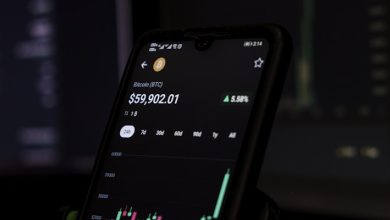What is Cryptocurrency Mining

- Introduction to Cryptocurrency Mining
- The Basics of Cryptocurrency Mining
- Understanding How Cryptocurrency Mining Works
- The Role of Miners in Cryptocurrency Transactions
- Cryptocurrency Mining Hardware and Software
- The Future of Cryptocurrency Mining
Introduction to Cryptocurrency Mining
Cryptocurrency mining is the process of validating transactions on a blockchain network by solving complex mathematical equations. This process helps secure the network and ensures that all transactions are legitimate. Miners are rewarded with newly minted coins for their efforts in verifying transactions.
One of the key components of cryptocurrency mining is the use of specialized hardware, such as ASICs or GPUs, to efficiently solve these mathematical equations. Miners compete with each other to be the first to solve the equation and add a new block to the blockchain. This process requires a significant amount of computational power and energy consumption.
As the popularity of cryptocurrencies has grown, so has the difficulty of mining. This means that miners need to constantly upgrade their hardware to stay competitive. Additionally, the reward for mining a block is halved approximately every four years, which can impact the profitability of mining operations.
Overall, cryptocurrency mining plays a crucial role in the functioning of blockchain networks. It helps validate transactions, secure the network, and incentivize participants to support the ecosystem. While it can be a complex and resource-intensive process, mining remains a fundamental aspect of the cryptocurrency industry.
The Basics of Cryptocurrency Mining
Cryptocurrency mining is the process of validating transactions on a blockchain network using computational power. Miners compete to solve complex mathematical problems, and the first one to find the solution adds a new block of transactions to the blockchain. This process requires specialized hardware and a lot of electricity to run the mining rigs.
One of the most popular cryptocurrencies to mine is Bitcoin, which uses a proof-of-work consensus algorithm. Miners are rewarded with newly minted Bitcoins for their efforts in securing the network. However, as more miners join the network, the difficulty of mining increases, making it harder to solve the mathematical problems and earn rewards.
To start mining cryptocurrency, you will need to invest in mining hardware, such as ASICs (Application-Specific Integrated Circuits) or GPUs (Graphics Processing Units). You will also need to join a mining pool, where miners combine their computational power to increase their chances of earning rewards. Additionally, you will need to set up a digital wallet to store your mined coins securely.
In conclusion, cryptocurrency mining is a competitive and resource-intensive process that plays a crucial role in securing blockchain networks. It requires specialized hardware, electricity, and a solid understanding of how mining works. While it can be profitable for some, it is essential to consider the costs and risks involved before diving into the world of cryptocurrency mining.
Understanding How Cryptocurrency Mining Works
Cryptocurrency mining is the process of validating transactions on a blockchain network. Miners use powerful computers to solve complex mathematical problems that verify the legitimacy of transactions. This process requires a significant amount of computational power and energy.
Miners compete with each other to be the first to solve the mathematical problem and add a new block of transactions to the blockchain. The miner who successfully adds the block is rewarded with newly minted cryptocurrency as well as transaction fees. This incentivizes miners to continue validating transactions and securing the network.
One key aspect of cryptocurrency mining is the concept of proof of work. This means that miners must prove that they have put in the computational effort to validate transactions. Proof of work helps to ensure the security and integrity of the blockchain network by making it difficult for malicious actors to manipulate the system.
As more miners join the network, the difficulty of mining increases, requiring more computational power to solve the mathematical problems. This is why mining operations often require specialized hardware and access to cheap electricity to be profitable. Despite the energy-intensive nature of mining, it plays a crucial role in supporting decentralized cryptocurrencies and ensuring the security of the network.
The Role of Miners in Cryptocurrency Transactions
Cryptocurrency miners play a crucial role in facilitating transactions within the blockchain network. Miners are responsible for validating transactions and adding them to the public ledger known as the blockchain. This process involves solving complex mathematical puzzles using computational power.
Miners compete with each other to be the first to solve these puzzles and add a new block of transactions to the blockchain. This process is known as mining, and miners are rewarded with newly minted coins for their efforts. The more computational power a miner has, the higher their chances of successfully mining a new block.
Miners also play a vital role in securing the network and ensuring its integrity. By validating transactions and adding them to the blockchain, miners help prevent double-spending and other fraudulent activities. Without miners, the cryptocurrency network would be vulnerable to attacks and manipulation.
Overall, miners are essential to the functioning of the cryptocurrency network. Their work not only helps process transactions but also maintains the security and decentralization of the blockchain. As the popularity of cryptocurrencies continues to grow, the role of miners in facilitating transactions will only become more important.
Cryptocurrency Mining Hardware and Software
Cryptocurrency mining requires specialized hardware and software to effectively mine various cryptocurrencies. The hardware used for mining is known as mining rigs, which consist of powerful processors and graphics cards. These components are specifically designed to solve complex mathematical algorithms required to validate transactions on the blockchain network.
In addition to hardware, miners also need mining software to connect their rigs to the blockchain network. This software allows miners to communicate with the network, submit their solutions, and receive rewards for their mining efforts. Some popular mining software includes CGMiner, EasyMiner, and NiceHash.
When choosing mining hardware and software, it is essential to consider factors such as hash rate, energy consumption, and compatibility with the cryptocurrency being mined. High hash rates indicate faster processing speeds, resulting in more successful mining attempts. Additionally, energy-efficient hardware helps reduce electricity costs, maximizing profits from mining activities.
Overall, investing in quality cryptocurrency mining hardware and software is crucial for successful mining operations. By carefully selecting the right components and software, miners can optimize their mining efficiency and profitability in the competitive cryptocurrency mining industry.
The Future of Cryptocurrency Mining
Cryptocurrency mining has rapidly evolved over the years, and the future of this industry looks promising. As technology advances, mining operations are becoming more efficient and sustainable. Miners are constantly looking for ways to increase their profits and reduce their environmental impact.
One trend that is gaining popularity is the use of renewable energy sources for mining operations. This not only helps miners cut down on energy costs but also reduces their carbon footprint. By harnessing the power of the sun, wind, or water, miners can ensure a more sustainable future for cryptocurrency mining.
Another development in the world of cryptocurrency mining is the shift towards more decentralized mining pools. This allows for a more democratic distribution of rewards among miners and helps to prevent centralization of power in the industry. Decentralized mining pools also offer increased security and transparency for miners.
As cryptocurrencies continue to gain mainstream acceptance, the demand for mining services is expected to grow. This will lead to more competition among miners, driving innovation and efficiency in the industry. With the right strategies and technology, miners can adapt to these changes and thrive in the evolving landscape of cryptocurrency mining.



